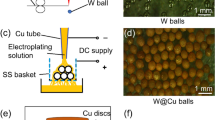Abstract
This study investigates the backward compatibility solder joint formed at high peak reflow temperature in aerospace industries. The backward compatibility solder joint is made up of lead-free ball grid array mounted on printed circuit board using tin–lead solders at a maximum reflow temperature ranging from 241.9 to 242.45 °C. The reflow process was conducted under a nitrogen atmosphere in a full convection reflow oven for 80.12–81.27 s. The scanning electron microscopy cross section of the solder ball depicts fairly uniform composition and phase distribution of the Pb-free plastic ball grid array and the tin–lead solder paste across all joints. Nanoindentation tests showed better mechanical properties with higher elastic modulus at 68.64 GPa and acceptable hardness value at 0.26 GPa as compared to those of Sn–Pb and Pb-free solder balls. Intermetallic compound formation at both joints seen in the scanning electron microscopy shows a scallop shape and randomly directed growth because of the uniformly distributed Pb-rich phase on the solder ball. The average intermetallic compound thickness measured by scanning electron microscopy equipped with energy-dispersive X-ray analysis was 3.633 μm, which was less than the specified thickness of 12 μm from the laboratory request.
Similar content being viewed by others
References
Vianco, P.; Rejent, J.; Artaki, I.; Ray, U.; Finley, D.; Jackson, A.: Compatibility of lead-free solders with lead containing surface finishes as a reliability issue in electronic assemblies. In: Proceedings of the 46th IEEE Electronic Components and Technology Conference, Las Vegas, pp. 1172–1183 (1996)
Zhu Q., Sheng M., Luo L.: The effect of Pb contamination on the microstructure and mechanical properties of SnAg/Cu and SnSb/Cu solder joints in SMT. Solder. Surf. Mt. Technol. 12(3), 19–23 (2000)
Zeng X.Z.: Thermodynamic analysis of influence of Pb contamination on Pb-free solder joints reliability. J. Alloys Compd. 348(1/2), 184–188 (2003)
Aerospace Engineering Specification—Soldered Electrical and Electronic Assemblies, HS 1009, 1–59 (2011)
Lee, N.C.: Reflow soldering Processes and Troubleshooting: SMT, BGA, CSP and Flip Chip Technologies. Elsevier, Newnes, 77 (2002)
Lau C-S., Abdullah M.Z., Che Ani F.: Computational fluid dynamic and thermal analysis for BGA assembly during forced convection reflow soldering process. Solder. Surf. Mt. Technol. 24(2), 77–91 (2012)
Zbrzezny, A.R.; Snugovsky, P.; Lindsay, T.; Lau, R.: Reliability of mixed solder interconnects—case studies. In: SMTA International Conference Proceedings, Celestica Inc (2005)
IPC.: J-STD-001E Joint Industry Standard Requirements for Soldered Electrical and Electronic Assemblies, pp. 1–72. Bannockburn, Illinois, USA (2010)
Snugovsky, P.; Zbrzezny, A.R.; Kelly, M.; Romansky, M.: Theory and practice of lead-free BGA assembly using Sn–Pb solder. In: Lead-Free Conference, CMAP Toronto (2005)
Banks, D.R.; Burnette, T.E.; Cho, Y.; DeMarco, W.T.; Mawer, A.J.: The effects of solder joint voiding on plastic ball grid array reliability. In: Proceedings of Surface Mount International (1996)
Yunus M., Srihari K., Pitarresi J.M., Primavera A.: Effects of voids on the reliability of BGA/CSP solder joints. Microelectron. Reliab. 43(12), 2077–2086 (2003)
Goenka, L.; Achari, A.: Void formation in flip chip solder bumps—part II. In: Nineteenth IEEE/CPMT Electronics Manufacturing Technology Symposium, pp. 430–437, 14–16 October 1996 (1996)
Arra M., Shangguan D., Ristolainen E., Lepistö T.: Effect of reflow profile on wetting and intermetallic formation between Sn/Ag/Cu solder components and printed circuit boards. Solder. Surf. Mt. Technol. 14(2), 18–25 (2002)
Klein Wassink, R.J.: Soldering in Electronics, 2nd edn, pp. 152–158. Isle of Man Electrochemical Publications Limited, UK (1989)
Erinc, M.: Thermomechanical fatigue failure of interfaces in lead-free solders. Technische Universiteit Eindhoven (2007)
Xiong, B.: Lead-free solder ball fragility. XILINX, Wp372 (1), 1–4 (2010)
Basaran C., Jiang J.: Measuring intrinsic elastic modulus of Pb/Sn solder alloys. Mech. Mater. 34, 349–362 (2002)
Hertzberg R.W.: Deformation and fracture mechanics of engineering materials, 4th edn. Wiley, New York (1996)
IPC.: IPC-A-610E—acceptability of electronic assemblies, pp. 1–420. Bannockburn, Illinois, USA (2010)
Author information
Authors and Affiliations
Corresponding author
Rights and permissions
About this article
Cite this article
Che Ani, F., Jalar, A., Ismail, R. et al. Backward Compatibility Solder Joint Formation at High Peak Reflow Temperature for Aerospace Applications. Arab J Sci Eng 41, 1813–1823 (2016). https://doi.org/10.1007/s13369-015-1986-1
Received:
Accepted:
Published:
Issue Date:
DOI: https://doi.org/10.1007/s13369-015-1986-1



